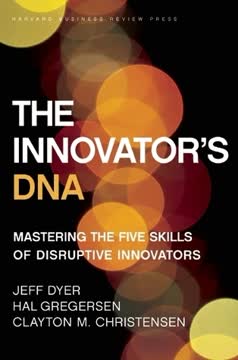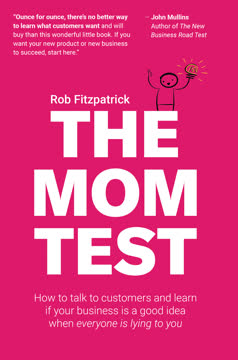Key Takeaways
1. Design Thinking Drives Innovation and Cultural Transformation
"Innovation by design" is not just a catchphrase; it's a powerful approach to problem-solving that can transform entire organizations.
Cultural shift: Design thinking is more than a methodology; it's a catalyst for cultural change. Organizations like Intuit, SAP, and GE have scaled design thinking across their workforce, training thousands of employees. This widespread adoption leads to:
- Increased collaboration across departments
- Improved problem-solving capabilities
- Enhanced customer-centricity
- Greater employee engagement and creativity
Transformative impact: The integration of design thinking often results in:
- Breakthrough products and services
- Improved customer experiences
- More efficient processes
- Increased revenue and market share
For example, Intuit's "Design for Delight" (D4D) program led to a $10 million increase in sales in the first year after implementing a simple change in their product offering based on design thinking principles.
2. The Pull Factor: Emotional Momentum in Design Thinking
The pull factor appears to be driven by all employee generations: Generation Z/ iGeneration, Generation Y/Millennials, Generation X, and Baby Boomers.
Natural engagement: The pull factor is the emotional momentum that draws people to participate in design thinking. It's characterized by:
- Voluntary involvement
- Increased enthusiasm for problem-solving
- Organic spread of design thinking practices
Multiplying effect: As more people engage in design thinking, it creates a snowball effect:
- Increased collaboration across teams and departments
- Higher levels of creativity and innovation
- Improved employee satisfaction and engagement
For instance, at Wells Fargo, Robin Beers observed that design thinking "enables a culture of care" and pulls people into engagement naturally. This engagement leads to more effective problem-solving and innovative solutions, as seen in their work with large customers, saving "millions" in time savings per day.
3. Finding the Right Problem is Crucial for Meaningful Innovation
"In the statement of the problem lies the solution."
Problem identification: Design thinking emphasizes the importance of identifying the root cause of issues rather than addressing surface-level symptoms. This involves:
- Deep customer empathy
- Contextual inquiry
- Reframing problems
Impactful solutions: By focusing on the right problem, organizations can:
- Create more meaningful innovations
- Solve complex, systemic issues
- Deliver higher value to customers
A prime example is GE Healthcare's redesign of MRI machines for children. By identifying the real problem - fear and anxiety in young patients - they created themed "adventures" that transformed the experience, reducing sedation rates from 80% to just two children per year.
4. Curious Confrontation: Facing Challenges with an Open Mind
Curious Confrontation: facing differing ideas and mindsets with the desire to investigate and learn.
Embracing differences: Curious confrontation involves approaching disagreements and challenges with:
- Open-mindedness
- Empathy
- A desire to learn and understand
Innovative outcomes: This approach leads to:
- More effective problem-solving
- Increased creativity and innovation
- Improved team dynamics and collaboration
For example, the Hunger Project continually reinvented its approach to ending hunger by confronting assumptions and asking, "What's missing?" This led to strategic shifts in focus, from political will to gender relations, resulting in more effective programs.
5. Co-Creation Unleashes Collective Creativity
Co-creation is an attribute that engages and leverages the three pillars of the collective imagination.
Inclusive innovation: Co-creation involves bringing together diverse stakeholders to collaboratively produce mutually beneficial outcomes. This includes:
- Customers
- Employees from various departments
- External partners and experts
Amplified creativity: The benefits of co-creation include:
- More diverse and innovative ideas
- Increased stakeholder buy-in
- Faster problem-solving and product development
Philips exemplifies this approach with its Co-Create process framework, which has led to billions of dollars in sales over the past few years. Their design thinking sessions are now integrated into the sales process, involving customers in envisioning future healthcare propositions.
6. Open Spaces Foster Collaboration and Innovation
"We are never more fully alive, more completely ourselves, or more deeply engrossed in anything than when we are playing."
Creative environments: Open spaces, both physical and virtual, are designed to:
- Encourage collaboration
- Stimulate creativity
- Facilitate spontaneous interactions
Innovation catalysts: These spaces contribute to:
- Increased idea generation
- Improved cross-functional collaboration
- Enhanced employee engagement and satisfaction
LEGO's new office in Billund, Denmark, exemplifies this concept with features like:
- Green roof gardens
- Play areas and mini-golf courses
- Informal meeting areas and hot desks
- A structure designed to resemble LEGO bricks
These elements create an environment that aligns with LEGO's commitment to creativity and play, fostering innovation throughout the organization.
7. Whole Communication Enhances Problem-Solving and Storytelling
The visualization of information and storytelling of problems and solutions are paramount to design thinking success.
Comprehensive expression: Whole communication involves using various forms of expression to convey ideas and solve problems:
- Visual representations
- Storytelling
- Data and analytics
- Emotional appeals
Enhanced understanding: This approach leads to:
- More effective problem-solving
- Improved stakeholder engagement
- Increased empathy and understanding of user needs
GE Healthcare's redesign of MRI machines for children illustrates the power of whole communication. By using storytelling and visual design, they transformed a frightening experience into an adventure, dramatically improving patient outcomes and business results.
8. Aligned Leadership is Essential for Design Thinking Success
True leaders don't create followers. They create more leaders.
Leadership commitment: Successful implementation of design thinking requires:
- Strong support from top executives
- Role-modeling of design thinking behaviors
- Empowerment of employees at all levels
Organizational impact: Aligned leadership leads to:
- Faster adoption of design thinking practices
- Improved innovation outcomes
- Cultural transformation
IBM's long history of design leadership, from Thomas Watson Jr. to current CEO Ginni Rometty, demonstrates the power of aligned leadership. Their commitment to design thinking has touched over 50,000 employees, driving innovation across the organization.
9. Purpose Drives Innovative Organizations
"Passion is caring deeply about something. Purpose is doing something about what you deeply care about."
Meaningful innovation: Purpose-driven organizations:
- Connect innovation to a larger mission
- Engage employees more deeply
- Create stronger connections with customers
Sustained success: A clear purpose leads to:
- Long-term innovation focus
- Increased employee and customer loyalty
- Improved ability to adapt to change
Johnson & Johnson's enduring mission "To help people live longer, happier and healthier lives" has guided their innovation efforts for decades. Their Care-Centered Design approach, directly tied to this purpose, drives innovation across their diverse business sectors and engages their 130,000 employees in meaningful work.
Last updated:
FAQ
What's "Innovation by Design" about?
- Overview: "Innovation by Design" by Thomas Lockwood and Edgar Papke explores how organizations can leverage design thinking to drive change, generate new ideas, and deliver meaningful solutions.
- Focus on Design Thinking: The book emphasizes the importance of design thinking as a methodology for problem-solving and innovation across various industries.
- Cultural Transformation: It discusses how design thinking can transform organizational culture to be more innovative and collaborative.
- Practical Insights: The authors provide case studies and examples from leading companies to illustrate the successful application of design thinking.
Why should I read "Innovation by Design"?
- Comprehensive Guide: The book offers a thorough understanding of how design thinking can be applied to foster innovation within organizations.
- Real-World Examples: It includes case studies from companies like Intuit, GE, and Marriott, providing practical insights into successful design thinking implementation.
- Cultural Impact: Readers will learn how design thinking can influence and transform organizational culture, making it more conducive to innovation.
- Actionable Strategies: The book provides actionable strategies and frameworks that can be applied to any organization, regardless of size or industry.
What are the key takeaways of "Innovation by Design"?
- Design Thinking as a Tool: Design thinking is a powerful tool for solving complex problems and driving innovation.
- Cultural Alignment: Successful implementation of design thinking requires alignment with the organization's culture and leadership.
- Scalability: Design thinking can be scaled across organizations to engage employees at all levels and foster a culture of innovation.
- Empathy and Collaboration: Empathy and collaboration are central to design thinking, enabling organizations to better understand and meet customer needs.
How does "Innovation by Design" define design thinking?
- Problem-Solving Approach: Design thinking is defined as a creative problem-solving approach that focuses on understanding user needs and developing innovative solutions.
- Key Tenets: It involves identifying the right problem, empathizing with users, collaborating across disciplines, and prototyping solutions.
- Human-Centered: The approach is human-centered, emphasizing empathy and understanding of the user experience.
- Iterative Process: Design thinking is an iterative process that encourages experimentation and learning from failure.
What are the 10 attributes of design thinking organizations according to "Innovation by Design"?
- Design Thinking at Scale: Organizations use design thinking as a strategic element of innovation and culture.
- The Pull Factor: Emotional momentum that draws people to engage in design thinking.
- The Right Problems: Focus on identifying and solving the root causes of problems.
- Cultural Awareness: Understanding and aligning design thinking with organizational culture.
- Curious Confrontation: Embracing ambiguity and curiosity to manage conflict and disagreement.
- Co-Creation: Engaging diverse groups in collaborative problem-solving.
- Open Spaces: Creating environments that promote creativity and collaboration.
- Whole Communication: Using diverse communication methods to engage stakeholders.
- Aligned Leadership: Leaders role-model and support design thinking.
- Purpose: Organizations have a clear purpose that guides innovation efforts.
How does "Innovation by Design" suggest organizations scale design thinking?
- Leadership Commitment: Scaling requires strong commitment and support from leadership.
- Training and Development: Organizations should train employees at all levels in design thinking methodologies.
- Cultural Integration: Design thinking should be integrated into the organization's culture and processes.
- Tailored Approaches: Each organization should find its unique path to implementing and scaling design thinking.
What role does empathy play in design thinking according to "Innovation by Design"?
- Understanding Users: Empathy is crucial for understanding user needs and experiences.
- Foundation of Innovation: It serves as the foundation for creating meaningful and user-centered solutions.
- Organizational Empathy: Empathy extends beyond users to include understanding and collaboration within the organization.
- Improved Communication: Empathy enhances communication and collaboration, leading to better problem-solving.
How does "Innovation by Design" address the challenge of cultural transformation?
- Cultural Alignment: Successful design thinking requires alignment with the organization's existing culture.
- Leadership Role: Leaders play a crucial role in modeling and reinforcing the desired cultural changes.
- Empathy and Inclusion: Emphasizing empathy and inclusion helps overcome cultural barriers to innovation.
- Iterative Change: Cultural transformation is an iterative process that requires ongoing commitment and adaptation.
What are some real-world examples of design thinking in action from "Innovation by Design"?
- Intuit's Design for Delight: Intuit's journey to embed design thinking in its culture, leading to significant innovation and growth.
- Marriott's Co-Creation with Customers: Marriott's use of design thinking to engage customers in co-creating their experiences.
- GE Healthcare's MR Adventures: GE's transformation of the MRI experience for children through design thinking.
- Philips' Co-Create Framework: Philips' use of design thinking to drive strategic transformation and innovation in healthcare.
What are the best quotes from "Innovation by Design" and what do they mean?
- "Imagination is more important than knowledge." This quote emphasizes the value of creativity and imagination in driving innovation.
- "Design thinking is the glue between all disciplines." It highlights the integrative nature of design thinking in bringing together diverse perspectives.
- "True leaders don’t create followers. They create more leaders." This underscores the importance of empowering others through leadership.
- "Passion is caring deeply about something. Purpose is doing something about what you deeply care about." It reflects the book's focus on purpose-driven innovation.
How does "Innovation by Design" suggest organizations manage conflict and disagreement?
- Curious Confrontation: Encourages embracing curiosity and ambiguity to manage conflict constructively.
- Empathy and Listening: Empathy and active listening are key to understanding different perspectives and resolving conflicts.
- Collaborative Problem-Solving: Design thinking provides a framework for collaborative problem-solving and conflict resolution.
- Open Dialogue: Promotes open dialogue and communication to address disagreements and find common ground.
What future possibilities does "Innovation by Design" envision for design thinking?
- Business Megatrend: Design thinking is seen as a significant emerging business megatrend with transformative potential.
- Cultural Innovation: The book envisions design thinking as a tool for designing innovative cultures and organizations.
- Educational Impact: Design thinking has the potential to transform education by fostering creativity and critical thinking.
- Global Influence: The authors predict that design thinking will continue to expand globally, influencing various sectors and industries.
Review Summary
Innovation by Design receives mixed reviews, with an average rating of 3.58/5. Some readers find it lacks depth and originality, offering only surface-level knowledge and case studies. Others appreciate its insights into design thinking culture and its impact on organizational innovation. The book explores ten attributes of design thinking and emphasizes the importance of leadership commitment. Critics argue it repeats common management concepts, while supporters value its descriptive analysis of success stories. Overall, it's considered a general introduction to innovation culture, suitable for beginners but lacking specifics.
Similar Books










Download PDF
Download EPUB
.epub digital book format is ideal for reading ebooks on phones, tablets, and e-readers.





